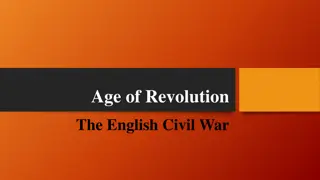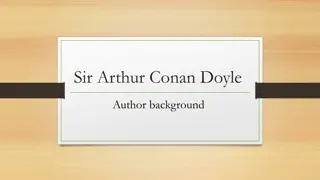Opposition to the Break with Rome in 16th Century England
The opposition to the break with Rome during the reign of Henry VIII in 16th century England was notable, leading to executions of prominent figures like Sir Thomas More and Bishop John Fisher. Despite some limitation of overt opposition, the English people were deeply connected to the papacy. The shift away from papal authority had significant implications for the monarchy and religious dynamics in England.
Download Presentation

Please find below an Image/Link to download the presentation.
The content on the website is provided AS IS for your information and personal use only. It may not be sold, licensed, or shared on other websites without obtaining consent from the author.If you encounter any issues during the download, it is possible that the publisher has removed the file from their server.
You are allowed to download the files provided on this website for personal or commercial use, subject to the condition that they are used lawfully. All files are the property of their respective owners.
The content on the website is provided AS IS for your information and personal use only. It may not be sold, licensed, or shared on other websites without obtaining consent from the author.
E N D
Presentation Transcript
Was the Opposition to the break with Rome widespread and dangerous?
Potential 12 markers on opposition (a) Explain why Sir Thomas More was executed in 1535. (a) Explain why Bishop John Fisher was executed in 1535. (a) Why were the monks of the London Charterhouse put to death by the Crown in 1535.
24 mark questions (b) How important was opposition to the break with Rome for Henry VIII s government in the years 1533 to 1535? (SBQ, Jan 2013) (b) Opposition to the royal supremacy posed a genuine threat to the government of Henry VIII in the years 1533 to 1535. Explain why you agree or disagree with this view.
Relative ease of the break has provoked comment Overt opposition was remarkably limited Yet, according to Richard Rex, the English kings and people were probably more attached to the papacy than any of their European counterparts
1478 the Spanish Inquisition had the effect of bringing the Spanish church under state control 1511, the French king Louis XII convoked a general council of the Church at Pisa to remove and dethrone Julius II - a move which undermined the primacy of the papal see. Yorkists, Lancastrians and Tudors until 1530 had all been papalists. Wycliffe s rejection of papal authority was specifically included in his condemnation by the Church in the 14thcentury. Diplomatic relations with Rome were becoming ever closer in the 15th century; Edward IV was the first English king to secure a cardinal protector for English interest at Rome. This policy was continued under Henry VII who was anxious to secure papal confirmation of his title to the throne. Love affair with pope continues with Henry VIII s securing the cardinal s hat for Wolsey and his assertio septem sacramentorum.
English theologians were not conciliarists John Fisher and Edward Powell produced length justifications of papal primacy.. There was a widespread reluctance among clergy to erase the pope s name from their service books in the later 1530s There was a steady stream of English pilgrims to Rome The pope, like the king, and ahead of him, was prayed for every Sunday in English in every church in the realm. Papal indulgences were widely available and popular! Many marriages depended upon papal dispensations Spiritual privileges among the gentry such as the ability to appoint a confessor, were much sought after
Cromwell s archives are littered with reports that reached him about opposition But he applied discrimination Drunks got off with a fright; The merely reluctant were induced to acquiesce; A number changed their minds after a meeting with Cromwell himself Only the systematically recalcitrant, of whom there were few, experienced harassment, imprisonment or worse. Nonetheless, acts of attainder went from 2 in the preceding 25 years of Henry s reign to 122 between the years 1534-47. There were 300 executions for treason. Cuthbert Tunstall, Bishop of Durham was scared out of his resistance to the supremacy by a raid on his palace at Bishop Auckland early in 1534 George Crofts, chancellor of Chichester confessed under interrogation after his arrest in 1538 that none act or thing ever more grieved his conscience than the oath he took to renounce the bishop of Rome s authority.
Keith Randells view The regime probably realised quickly that opponents fell into two categories those (a tiny minority) who would refuse to accept the changes whatever was done to them, Those (the large majority) who would fall into line provided the stakes were raised high enough The small number of unyielding opponents must be destroyed, partly to act as a warning to others The mass of less determined doubters must be forced into positive acceptance of the new situation by threatening them with dire consequences if they did not Treason Act was passed in 1534 provided the mechanism. But silence was not to be allowed to protect the passive majority of dissidents Within the legislation confirming the break with Rome the Royal Supremacy and the Act of Succession clauses were inserted requiring the entire population to swear oaths supporting the new arrangements. Death was promised to those who refused.
The opponents in 1535 Thomas more Bishop John Fisher Elizabeth Barton the Holy maid of Kent Carthusian monks of the Charterhouse.
Executions of the Holy Maid, John Fisher, Thomas More and the Carthusians, kept that elite, particularly the all-important clergy, from openly expressing its discontent.
Defenders of Catherine Developed at court in opposition to Wolsey Thomas More Bishop John Fisher Sir Nicholas Carew gentleman of the privy chamber Henry Guildford controller of the Household Lords Darcy and Hussey Opposition was silenced by executions of More and Fisher and the effective exile from court of Darcy and Hussey (who was in charge of Princess Mary s household). Monks of London Charterhouse Carthusians, very strict. 5 refused to swear an oath of loyalty.
Read the handout Who opposed the Reformation .




![Stakeholders' Responses to National Health Insurance Bill [B.11B-2019]: Overview](/thumb/69945/stakeholders-responses-to-national-health-insurance-bill-b-11b-2019-overview.jpg)


















